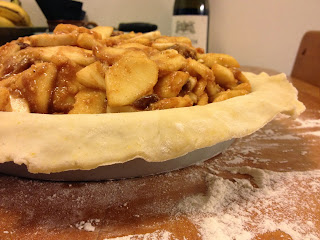The cookies are wonderfully spicy (thanks to a good quantity of fresh and dried ginger), can be cooked to snappy perfection or to chewy goodness. The traditional rolling in Demerara, turbinado or other large-crystal sugar is a classic, but topping with a small piece of crystallized ginger or leaving them plain is perfectly acceptable too.
This recipe is remarkably easy, requiring one a few pieces of equipment and can be done entirely by hand. What's more: the dough can be make a few days ahead, made into balls at you leisure, baked off when you want (or when guests pop in…or when you really just want a fresh gingersnap…). Alternatively, you can freeze pre-made balls, thaw overnight in the fridge, then bake. So really, there is no excuse. Get snaping'!
Spicy Ginger Snaps
Adapted from Alice Medrich's recipe in "Pure Desserts"
Makes about 48 to 52 small, 2" cookies
2 cups all-purpose flour
2 teaspoons baking soday
2 heaping teaspoons dried ground ginger
2 teaspoons cinnamon
1/2 teaspoon fresh ground nutmeg
1/2 teaspoon salt
pinch cardamon, garam masala (optional)
8 tablespoons unsalted butter
1/4 cup un-sulphered molasses
1/2 cup white sugar
1/3 cup firmly packed brown sugar
2 heaping tablespoons freshly grated ginger*
1 large egg
3/4 cup crystallized ginger, chopped finely**
1/2 cup Demerara or Turbinado sugar for rolling
1/3 cup crystalized ginger, cut into small pieces for topping
*Use a zester with larger holes, a microplane, or as I did this year: peel and cut the ginger root into small pieces, and pulse in a coffee or spice grinder until smooth, scraping the edges of the grinder between pulsing.
**The original recipe calls for mixing in the finely chopped crystallized ginger, but I find that omitting this does not impact the awesome-ness of this cookie. I bump up the fresh grated ginger to compensate, but feel free to add the crystallized ginger if you love it!
Equipment:
1 medium sized sauce pan (make sure it is large enough to hold the entirety of the dough, since this will be your main mixing vessel)
Sifter
Small bowl for spice measuring
Rubber spatula
Wooden spoon
Measuring cups and spoons
Bowl for rolling sugar
Ordinary metal kitchen spoon
Baking sheets with parchment
Thin metal or plastic spatula for removing cookies
Cooling rack
Method:
In the sauce pan, melt the butter over low to moderate heat. Once melted, remove from the heat completely. Add the sugars and the molasses. Mix thoroughly with a rubber spatula. Crack in the egg, and stir vigorously. It is imperative that the pan is not hot, or else the egg will curdle.
Now, grab your sifter, spices, and baking soda, and measure into a small bowl. Admire how amazing they all are!
Measure the flour into the sifter directly over the with the wet ingredients, add the spices, and sift into the pan. Now, with the rubber spatula or a more sturdy wooden spoon, mix everything thoroughly together. It may take a touch of muscle-but deal with it-this is worth it.
Now, allow the dough to rest for a few minutes. Pre-heat your over to 350F, and assemble the rolling sugar and/or chop the small pieces of crystallized ginger for on top. Grab sheet pans, and line with parchment, and set up a cooling rack of sorts (towels laid flat over newspaper or brown paper bags work in a pinch).
Or, place the dough into the fridge and store it here until you are ready to bake. The dough will keep up to 1 week, if tightly covered to prevent drying.
If baking immediately, using a spoon, scoop out enough dough to make a ball the size of a small walnut. Roll in your hands, and then toss into the rolling sugar, rolling gently to help the sugar adhere. Place on the lined cookie sheet, spacing each cooking about 2" apart as they do spread If topping with the piece of crystallized ginger, place the dough ball on the sheet then gently press the piece into the cookie ball (the piece will be off-cenetered if now pressed firmly, but it's not a big deal if they do slide a bit…a few of mine always do).
Bake at 350F for 10 to 12 minutes. If you want more chewy snaps, bake until about 1/2 of the cookies have deflated. If you want snappy snaps, bake until almost all have collapsed. But of course, taste and test, and adjust according to your preference!
Enjoy, or pack into cute bags or boxes, and give to the people you adore, along with other goodies like freshly made filled truffles and hand-rolled truffles:




















































